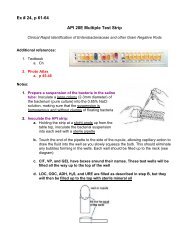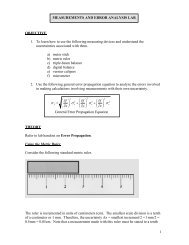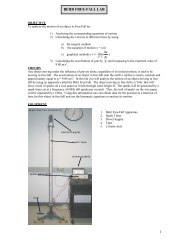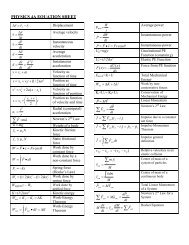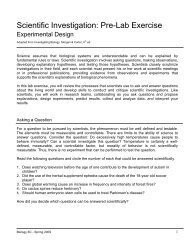GAMMA-RAY SPECTROSCOPY - De Anza College
GAMMA-RAY SPECTROSCOPY - De Anza College
GAMMA-RAY SPECTROSCOPY - De Anza College
Create successful ePaper yourself
Turn your PDF publications into a flip-book with our unique Google optimized e-Paper software.
<strong>GAMMA</strong>-<strong>RAY</strong> <strong>SPECTROSCOPY</strong>INTRODUCTION/THEORYThis experiment will demonstrate that excited atomic nuclei occupy discrete and unique nuclearenergy levels in much the same way that excited atoms exhibit discrete and unique atomicenergy levels. When an atom undergoes a de-excitation transition, a photon is often emittedwhich carries off energy equal to the difference in energies of the two electronic levels involved.An analogous phenomenon occurs in nuclear transitions between nuclear energy levels. Thephotons emitted in nuclear transitions are called gamma-rays and generally have energies severalorders of magnitude greater than atomic photons.In both the atomic and nuclear processes, the resulting photon spectrum is unique and provides ameans of identifying either the chemical element or radioisotope present. The fact that theradiation pattern (spectrum) of each radioisotope is unique and the very high detectionefficiencies of nuclear counting systems, facilitates many useful scientific applications ofradioactive materials - medical diagnosis, biological and chemical tracers, neutron activation,etc.The gamma-ray spectrum will be obtained by using a Sodium Iodide (NaI) Scintillator <strong>De</strong>tector.The atoms of these type of detectors are easily excited by radiation and produce a spectrum thatis characteristic of the chemical element present. A typical diagram of a NaI detector is shownbelow.Scintillator Crystal (NaI)Photocathode0 V+150 V+300 V Photomultiplier Tube+600 V+450 V+ 900 V +750 VOutput SignalWhen a gamma-ray strikes the NaI crystal some of the atoms in the crystal will become excitedand then emit photons as the atoms fall to their lower energy state. These photons will thencollide with a plate called a photocathode and as a result electrons will be ejected due to thephotoelectric effect. At the end of the photocathode a device called a photomultiplier (PM) isattached. The PM tube consists of several electrodes, called dynodes, whose electric potentialsincrease in succession along the tube. When an electron is ejected from the photocathode it will1
accelerate towards the first electrode having sufficient energy to eject several electrons. Theseelectrons will then be accelerated towards the second electrode and eject several more electrons.This multiplication process continues until the electrons (several millions) reach the lastelectrode. The result is an electrical pulse at the output signal of the PM tube that is convertedinto a voltage pulse whose size is proportional to the gamma ray’s energy.The voltage pulse is amplified and measured by an analog-to-digital conversion (ADC) process.The result of this measurement is an integer between 0 and 1023 for a 10-bit ADC. Zero is themeasure for a voltage pulse less than a hundredth of a volt, and 1023 is the measure for a pulselarger than about 8 volts (or the largest voltage pulse accepted by the ADC). Pulses between 0Vand 8V are proportionately given an integer measure between 0 and 1023. This measure iscalled the channel number. The analog to digital conversion is performed by the interface cardthat is installed in the computer. The computer software that comes with the hardware recordsand displays the number of gamma rays observed for each channel number. The screen displaysthe number of gamma rays as a function of the channel number.Calibration with sources of known energies allows you to correlate the channel number with thegamma energy. The result is a graph of the frequency (counts) as a function of gamma-rayenergy (channel number). Figure 1 below is a calibrated spectrum. The photopeaks have beenlabeled; other structures in the data will be discussed in future experiments.2
OBJECTIVEA. Learn how to calibrate a gamma-ray spectroscopy system.B. Identify two unknown radioactive sources by analyzing their gamma spectra.C. Calculate the resolution of the system.EQUIPMENT1. NaI detector2. Computer-Based MCA (multi-channel analyzer-already installed inside computer)3. 22 Na source, 137 Cs source, 2 unknown radioactive sources.CALIBRATION PROCEDURE1. Start the ICS10 multi-channel analyzer program:Select Start--->Programs--->SpecTech--->Icsw322. Click on Setting on the menu, then click on AMP/HV.3. Set the High Voltage to 550 V, click ON.4. Set the amplifier COARSE GAIN to 4 and set the FINE GAIN to 1.498 .5. Set the Lower Level Discriminator (LLD) to 2.1 and the Upper Level Discriminator(ULD) to 106.2. These settings are used to eliminate unwanted noise and high energysignals.6. Set the Conversion Gain to 1024.7. Place the 22 Na source near the crystal end of the detector. Begin collecting data by clickingon the green start button at the upper-left side of the screen.8. Acquire data for approximately 5 minutes or until you see a “well-defined curve”. Stopcollecting data by clicking on the red stop button at the upper-left side of the screen. Yourspectrum should look like figure 2 below.3
9. You will now perform a 2-point calibration:A. Select Setting--->Energy Calibrate--->2 point calibrationB. Position the marker at the highest channel of the first peak and enter 511 KeV. Move themarker to the high point on the second peak and enter 1274 KeV.C. The system is now energy calibrated and the marker position will read directly in energy.D. Print the 22 Na spectrum.10. Check the calibration of the system by using the 137 Cs source. The observed peak should becentered near 661.6 keV. If it is not within 10 keV of the accepted value, you will need to recalibratethe system. Print the 137 Cs spectrum.EXPERIMENTAL PROCEDURE1. Place one of the unknown sources near the crystal end of the detector and acquire data forapproximately 15 minutes or until you see a “well-defined” curve.2. Select an ROI (region of interest) for each displayed peak on the spectrum.A. Click the right mouse buttonB. Click on ROIC. Move the marker to either side of the peak.D. Hold down the left mouse button and drag the marker to the other side of the peak andrelease mouse button.3. When clicking on a ROI the screen will show several important information about that peak.One will be the centroid energy. Check that the centroid energy agrees with the peak energyby locating the marker at the highest point of the peak.4. Print the spectrum.5. Select Display--->Data Report and print out Data Report for spectrum.6. Repeat steps 1-5 for the second unknown.ANALYSISA. Using the spectrum for unknown #1 source identify the radioactive element. Refer to thetable ‘List of Commonly Observed Gamma Energies’ to identify unknown sources.B. Using the spectrum for unknown #2 identify the radioactive element.C. <strong>De</strong>termine the fractional energy resolution of one of the gamma energy peaks for each of theunknowns.Fractional energyenergy spread of peak at half heightresolution ==peak energyFWMHpeak energyD. Calculate the % error for the calculated gamma-ray energies and the expected valuesE. Comment on sources of errors involved.4









